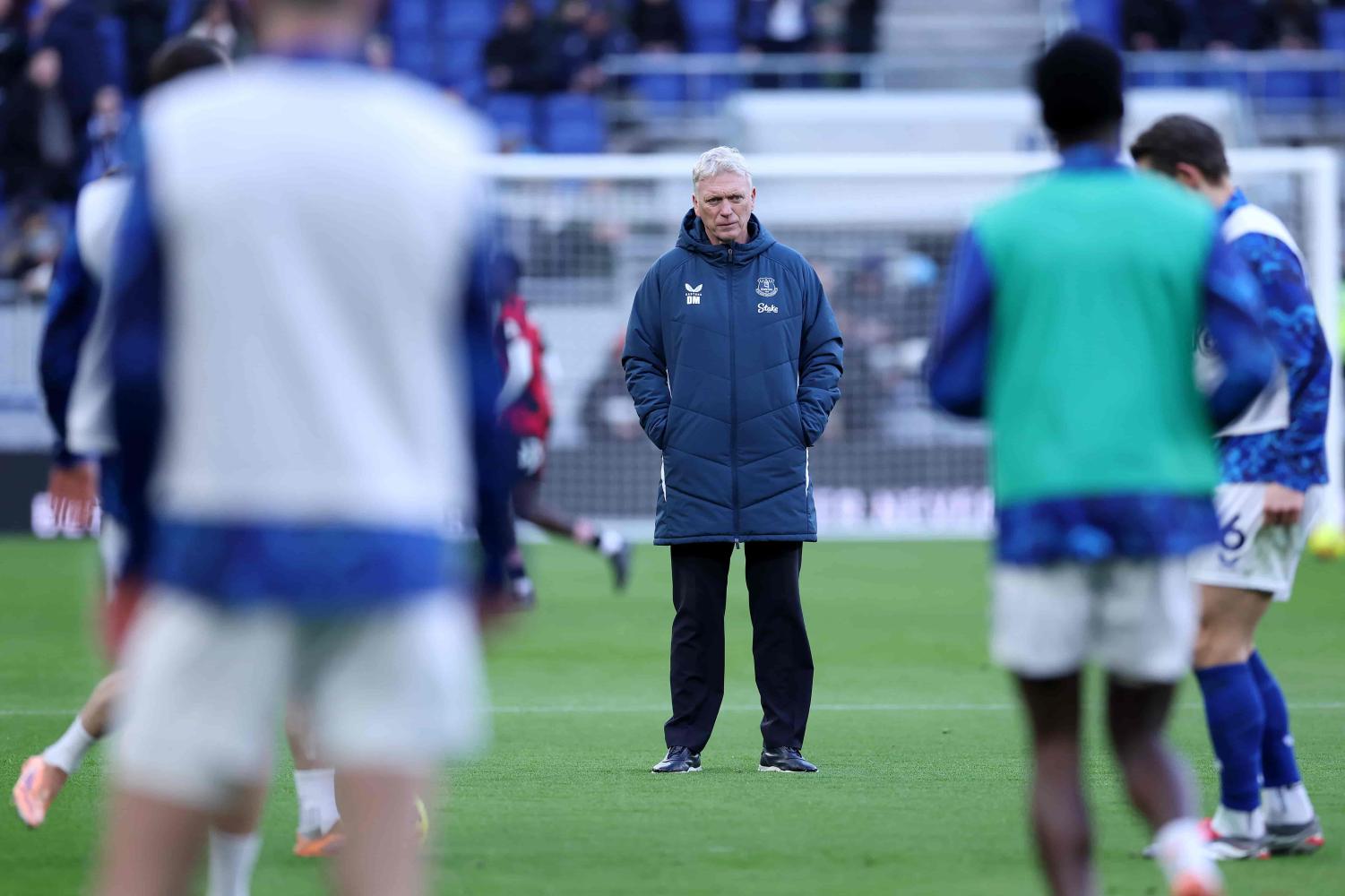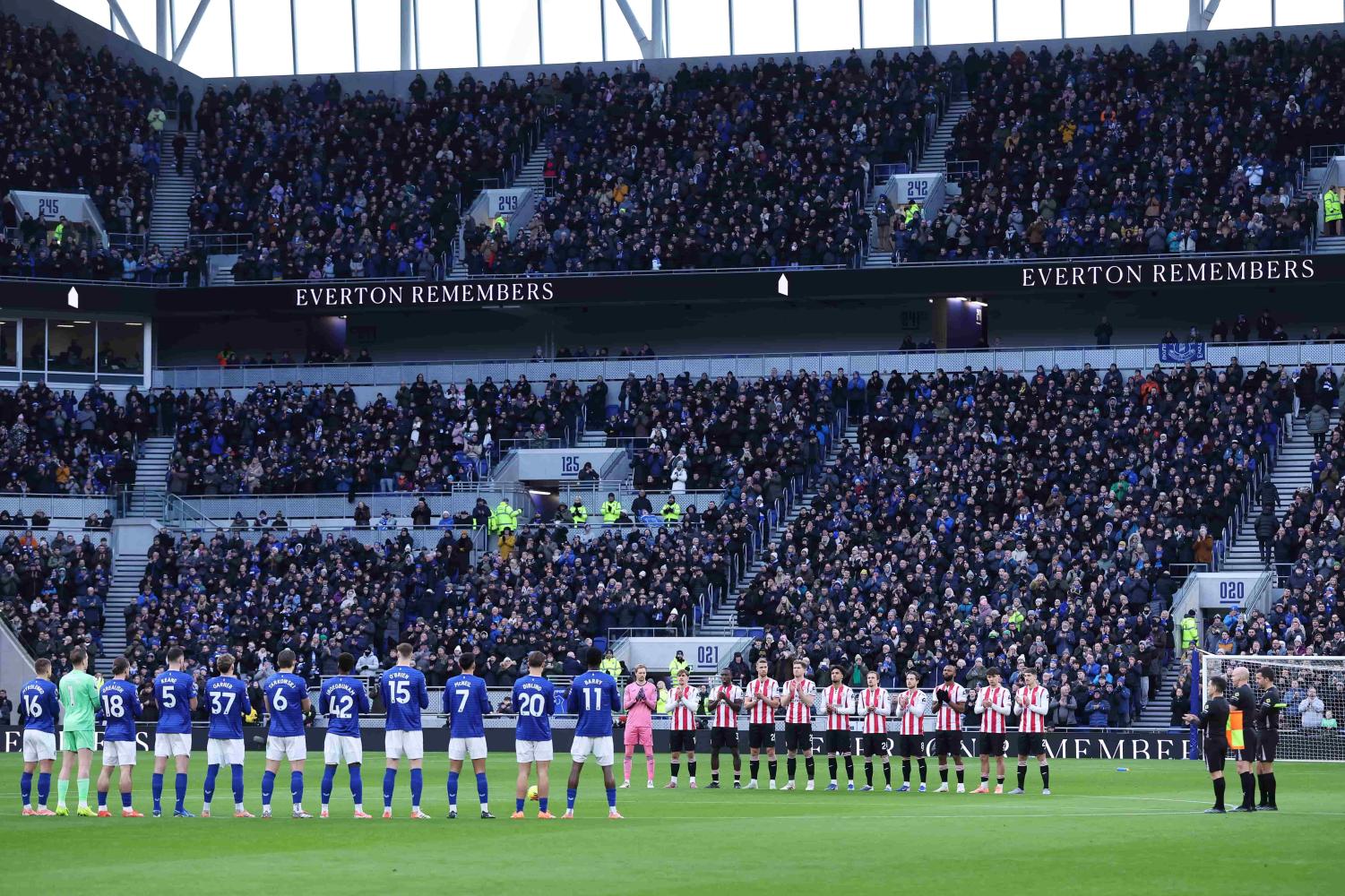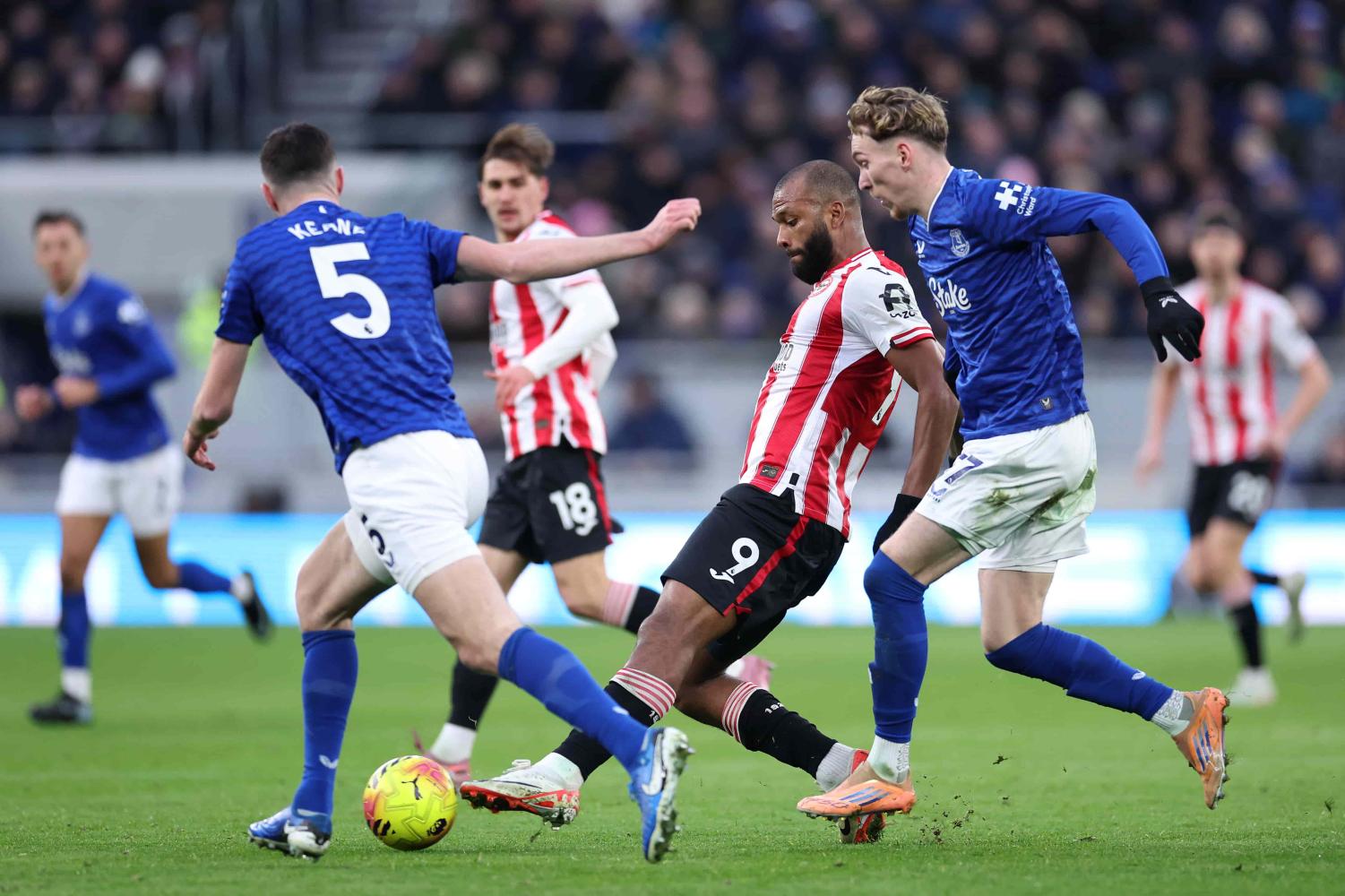Goodison Park – An Objective View
Late in 1995 this article was published by Everton fan, John Burns. It was to stimulate much discussion, debate and thought among Evertonians starting the Internet campaign promoting Everton's move to a state-of-the-art stadium.
The Motto of Everton Football Club is the Latin, Nil Satis Nisi Optimum. It translates to Nothing But The Best Satisfies. This also applies to the ground the club plays on, Goodison Park. Until recently this was very true, by English standards. Goodison Park, Everton's fourth home, from its early conception was superior to all English league grounds. The only ground ever with four double-decker stands. It was so far ahead of its English counterparts that it hosted the 1966 world cup semi-final between West Germany and the USSR. There wasn't even a close second. This was an illusion. The standards of sports stadia in similar sized countries on the European continent have generally been vastly superior to Britain. Goodison Park was not satisfying the club motto.
How times have changed. Goodison Park was rejected in favour of Evertons' previous home, Anfield, to host the EURO 96 championship finals. Many club's now have grounds that may be not as capacious, but are superior in the modernity, viewing positions and amenities they offer. To name a few, Arsenal, Liverpool, Manchester City, Manchester United, Middlesborough, Newcastle United, Sheffield Wednesday, Tottenham Hotspur and Wolverhampton Wanderers. Goodison Park has declined to a second status of English League club grounds.
The ground has lacked investment, and more importantly there has never been any serious "long term plan" to develop the ground into a "complete high quality stadium". If there was a plan it certainly was not followed.
The ground consists of uncompromising individual cheaply made structures on all four sides, with only one corner accommodating spectators, but only on an upper deck. The ground has one of the largest capacities in England, of over 40,000, which by European super-club standards is minuscule.
UNSUITABLE SITE
The site is, and has been for most of its existence, too small for the clubs' requirements. It is excessively hemmed in on three sides by dowdy Victorian terraced houses that have exceeded their builders envisaged life cycle and a church site that is only a few yards from the pitch. The site reflects the clubs small beginnings.
The club had outgrown the site at the turn of the century.
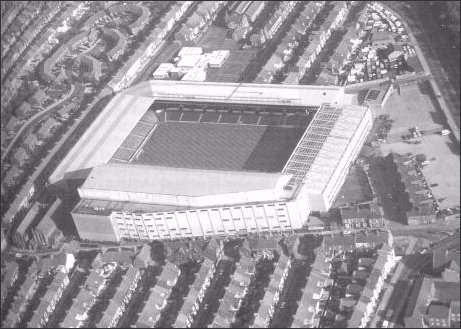
Hemmed In : Road Cuts Into The Site : Church Takes Up Corner
The old 1907 Park End stand was built around one of the end corners of a row of terraced houses. This angular intrusion into the stand was clearly visible from inside the ground. The row of houses was demolished to improve the stand's access for the 1966 world cup. Space to expand has always been a problem, that to build the Gwladys Street stand in the 1930's a row of terraced houses was purchased and demolished.
The site is not a complete rectangle. Goodison Road cuts into the site near the Stanley Park end, noticeable from inside the ground by the severe incline of the back wall of the Main stand.
Being surrounded on three sides by dense residential housing the club is a nuisance to residents on match days. Supporter's access to this inner-city ground is less than ideal due to the enclosed proximity.
This enclosed proximity raises safety questions. As a 40,000 crowd is filing out of the ground all the local roads are excessively crammed with people and cars. If a fire breaks out in one of the local houses, access to the vicinity by the emergency services would be greatly hampered, maybe resulting in serious injury or loss of life.
In the early 1920's football was being firmly established as Britain's, and the worlds, major sport. With attendance's rising rapidly, the club should have been realistic and moved to a more suitable site, before embarking on the re-building of the Bullens Road and Gwladys Street sides of the ground.
THE CANTILEVER REVOLUTION
The first cantilever stanchionless stand in England was a small construction at Scunthorpe United in 1958. The first major cantilever stanchionless stand was the wonderful large side stand at Sheffield Wednesday. Built in 1961, it set the standards for all to follow. Liverpool followed in 1963, with the Kemlyn Road stand, and Manchester United implemented for the 1966 world cup a side stand, complete with private boxes.
Unlike Liverpool, Sheffield Wednesday and Manchester United had long term "stadium" plans to extend their stands to all four sides to create complete bowls. Manchester United took 30 years to accomplish their plan. Unfortunately Sheffield Wednesday abandoned theirs, subsequently building cheap piecemeal structures - the tragic Leppings Lane stand being one of them. Recently even Newcastle United - who, for a large club, occupied an appalling ground - have completed a stanchionless bowl of a stadium featuring in EURO 96.
Newcastle United are considering a proposed move to a larger stadium of approximately 70,000 capacity. The new Amsterdam Arena is being analysed and maybe used as a role model. Despite investing substantial millions in the present stadium, John Hall the Newcastle United chairman, is prepared to look to the future invest and move.
THE MAIN STAND - A WHITE ELEPHANT
In 1969 the old Archibald Leitch designed, Goodison Road stand, of 1909 was demolished to make way for its replacement, the Main Stand, opened in 1971.
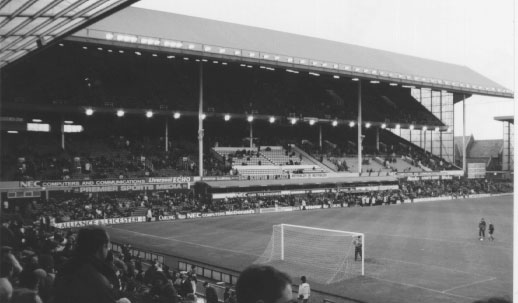
Main Stand From The Park Stand. See how close the church is to the pitch.
What an ugly white elephant this turned out to be. A cheap double-decker construction with an unusually large amount of large support stanchions supporting the upper balcony and large forward leaning roof. It was clearly obvious that this stand was not part of any serious long term stadium plan.
Extending cleanly to the other sides of the ground is extremely difficult, if at all possible. A stairwell shaft at the Stanley Park end of the stand fills in that corner of the ground, and the church site at the other corner hinders any proposed extension.
Ten years after Sheffield Wednesday established the cantilever standard, which the major clubs were following, Everton build yet another structure with view obscuring support stanchions. Many seats under the top balcony are excessively obstructed, making viewing uncomfortable. Only a few years later, Chelsea built a superb, triple-decker stanchionless stand, designed to expand and form a complete stadium. A fine example of how to do it properly, although unfortunately Chelsea never extended the stand.
THE BULLENS ROAD AND GWLADYS STREET STANDS
The Archibald Leitch creations, the Bullens Road and Gwladys Street stands, date from 1926 and 1938 respectively. They have a large wood content in their construction, with far too many support stanchions obscuring spectators' views of the playing pitch.

Bullens Road From The Main Stand
The rake of the bottom tiers, which is converted terracing, is seriously shallow with the stands too near the playing area. This combination causes spectators to stand to view playing action near the touchlines. Re-construction is required to both of these sides of the ground.
THE NEW PARK STAND - ANOTHER WHITE ELEPHANT
The only side of the Goodison Park site that has room to expand is the Stanley Park end. In 1994 a new single tier cantilever stand was opened to replace the old 1907 double-decker construction.
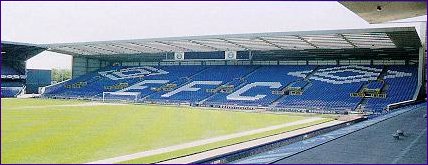
The inadequate Park Stand
This individual stand-alone effort broke with the double-decker tradition of Goodison Park. It does not complement any of the adjacent structures, the Main and Bullens Road stands, and appears not to be a part of any "long term stadium plan".
The roof actually protrudes under the higher overhanging roof of the Main stand, obscuring views of a section of seats on the top balcony of the Main stand. A lot of criticism was directed at the club due to its very small capacity. It occupies the only side of the ground that has any area for easy expansion. It has the appearance of many of the cheap structures seen in English first division grounds.
One can only assume that this was constructed as the Football Trust contributed a substantial amount towards its construction. Did the club accept the money because it was available, resulting with a wholly unsuitable structure? This appears to be short term gain, long term loss. One hopes that this structure is regarded by the club as temporary.
THE FUTURE
What of the future? The club have never been wholly open about any immediate or long term plans for Goodison Park. Is there a master plan that will eventually turn Goodison Park into a Twickenham? or a move to an indoor arena? If so will it be adhered to? The old Twickenham, with its double-decker Archibald Leitch stands was very similar to Goodison Park.
The finest team sport stadium in Britain is the new Twickenham rugby stadium. Ideally an indoor Twickenham with a retractable roof would have been an even better prospect, eliminating the unpredictable, cold, wet British climate. When the remaining one end is complete, Twickenham will be a triple tier, 80,000 plus seater, covered, stanchionless bowl. It is a magnificent structure with superb amenities. A fine example of how to build a stadium in phases. Although currently the best in Britain, Twickenham is very basic in comparison to the state of the art stadia elsewhere.
If Everton want to live up to its motto then the Amsterdam Arena is surly the stadium to emulate. The new home of Ajax Football Club, opened in autumn of 1996, it is the most advanced stadium complex in Europe. It is the first stadium in Europe that is a complete entertainment complex featuring a retractable roof. It consists of cinemas, pubs, restaurants and crèche facilities among others. It is designed from the outset to host concerts as well as football, featuring a semi-synthetic grass pitch. Car parking is beneath the stadium in levels with access directly from a highway, which also runs under the stadium, alleviating urban traffic congestion. There was 65,000 season ticket applications for a 52,000 capacity. A green field site, the complex was a joint venture with many parties including the City of Amsterdam. This complex is without doubt the model facility Everton should be aiming for.
If Everton occupied a scaled down version of a Twickenham style of stadium or the pretigious Amsterdam Arena, it would be in contention to stage England international matches and European competition finals. A great boost to the "big European club" image Everton are supposed to aspire.
Proposal 1 - A New Green Field Site
Many English league clubs have abandoned their existing grounds and moved to new green field or suitable sites. Modern construction techniques and in some cases inventive joint business deals with other parties, have made it cost-effective to construct complete stanchionless mini-stadiums. Huddersfield, Middlesborough and Millwall have fine recent examples. Many more clubs have plans to move to new sites, Bolton Wanderers, Luton Town, Portsmouth and Southampton among them. Sunderland as to clear the site of their new stadium.
The high value of the inner-city sites many of the old grounds occupied offset the total construction costs, rendering these projects feasible. No club that has moved has encountered problems with their support. The vast majority have openly accepted the new stadiums, and are more than happy with the vastly improved amenities and road access the new stadiums now provide.
The days have long gone when most clubs were supported by the immediate local community. As most clubs now have wide catchment areas of support, these moves have provided excellent transport communications vital for club expansion. The improved amenities have resulted in increased attendances. Everton occupy a valuable inner-city site.
In the last century, Everton moved from Anfield to Goodison Park, situated in the Walton district of Liverpool, resulting in increased attendance's. The supporters openly welcomed the move to a superior ground. Everton had abandoned a ground on which they had won a championship and hosted an international match - England v Ireland.. The fans approved of the resulting progress. A new green field site with a Twickenham style or Amsterdam Arena complex adjacent to rail, local road and motorway arteries, would improve the clubs support and image greatly.
Proposal 2 - Combine With Other Local Sports Organisations
Combining with other local sports organisations in the immediate area makes economic sense. There is great potential for growth by all parties concerned. In the past it had been suggested that Everton, Liverpool and the Aintree racecourse authorities combine to build a large stadium at the course. The idea was never taken seriously, but that was before the Taylor report cast a new aura over football ground design.
Large stadium sharing is common in Italy, were all the sharing clubs and fans benefit greatly. A stadium at Aintree could house restaurants, conference facilities, private suites and boxes that would be suitable for use on race and match days. A back-to-back main stand could double function for football and racing. The facilities could also be used on a general commercial basis.
The course has an adjacent Merseyrail underground station that links with main line British Rail at Lime Street, and excellent local road and motorway links. A complex which is home to the worlds greatest horse race spectacle and two famous old football clubs would bring prestige to all parties and the Liverpool area.
Wimbledon share Selhurst Park with Crystal Palace. This is a less than ideal arrangement were Wimbledon are tenants, with little say, if any, in the development of the ground. They have also moved out of their support catchment area. Wimbledon are contemplating a new green field site stadium closer to Wimbledon. Crystal Palace's previous tenants Charlton Athletic, moved out because of the same restricting situation. Wimbledon, a club with minuscule attendance's have managed to maintain ten years in the top division. The reduced overheads of not having to maintain a single ground, have reflected on this small clubs success.
The prospect of stadium sharing, with joint ownership, may sound abhorrent to a minority of Everton and Liverpool fans, but this is sound economic sense. Both have the same support catchment areas. Stadium sharing in Italy has not resulted in a lack of partisanship or local rivalry. The prestige and image boost all parties and the Liverpool area would gain is incalculable. There would be a domino effect of future investment into the area, as has occured in US cities, boosting the local economy.
If the thought of stadium sharing with Liverpool is so abhorrent to Everton, one hopes that they are not so narrow mindedly bigoted, Everton and the Aintree authorities could pursue this idea together with the Amsterdam Arena as the role model. Both parties would greatly benefit.
Shamefully no organisation in the City of Liverpool entered a proposal for the recent national stadium competition. If a similar joint proposal was tendered, there was a high probability of winning. Being the most famous British city, apart from London, Liverpool is the only city that can seriously compete with the capital.
Proposal 3 - Expand and Develop the Existing Site
To achieve a Twickenham or Amsterdam Arena style of stadium, or any other style, at Goodison Park would be impossible with the existing site. It is far too small. The church site, the school located at the corner of Gwladys Street and Bullens Road, the Bullens Road surface itself, a number of terraced houses that run off Bullens Road and the remaining terraced houses behind the Park stand would need to be purchased and/or demolished to accommodate a modern Twickenham style of stadium.
The purchase of immediate buildings and land to create a larger stadium would render this an expensive project for minimal return. With an increase in capacity, supporter's access will be further hampered due to the closed-in site. Local residents would naturally oppose such radical planning proposals to their environment, maybe resulting in lengthy delays and court cases.
INTO THE NEXT CENTURY
Everton have to encompass radical change for the coming millennium. The existing Goodison Park site is a legacy of the clubs small beginnings, gaining its support from the immediate local community. The site is now wholly unsuitable, and the club should fully recognise this.
The image of the club on a British and European level, despite the team success in the past twelve years, is lacking. It is below the levels of Liverpool, Manchester United and the two large North London clubs. The conservative parochial attitude of the past has to be replaced with a European super-club attitude. This is what the club is supposed to aspire to.
All large European super-clubs have large modern stadiums. Bayern Munich moved from a small ground to the impressive Olympic stadium and never looked back. They were raised to European super-club status. The increased support and image resulted in the necessary funds to promote the team and club, maintaining the status, image and success. Very few British people in the 1950's and 1960's had heard of this German club. Manchester United, who currently occupy the finest league ground in England, realising the potential won the right to occupy the proposed Olympic stadium if the city of Manchester were awarded the games.
Everton need to embark on a major feasibility study leading to a meaningful construction programme. The preferable conclusion would be a break with the past resulting with a green field site or stadium sharing. The values and traditions of the club will not die, they will continue as they always have, are very important, and are more than a firm base to build upon. You have to know where you come from to know where you are going. A firm vision of a progressive future should be "cast in concrete", preferably in a "long term corporate plan". Once constitutionalised, there is a high probability that future administrations will adhere to it.
There was radical change in 1892 when the club moved from Anfield to Goodison Park. Everton took the lead and produced Britain's first developed football ground, setting the standard for all others. The club never looked back and benefited greatly. Everton should again take the lead in standards and develop the next phase of British football stadia with the Amsterdam Arena firmly focused as a role model. Moving to a superior facility and location is merely another phase in the evolution of an old, historical and innovative club.
Radical change is beckoning for the millennium. Nil Satis Nisi Optimum.
John Burns



